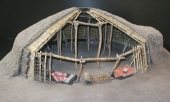
 4
4























 1
1








 ) I have a post here at Permies I have been working on and need to finish on Fossorial Architecture and other Indigenous Earth Lodges, which will also have links. For now, lets see where this takes you and if there is any questions...
) I have a post here at Permies I have been working on and need to finish on Fossorial Architecture and other Indigenous Earth Lodges, which will also have links. For now, lets see where this takes you and if there is any questions...




 I don't have any real goal aside from curiosity, so you've given me more than enough to complete my homework.
I don't have any real goal aside from curiosity, so you've given me more than enough to complete my homework.








"Where will you drive your own picket stake? Where will you choose to make your stand? Give me a threshold, a specific point at which you will finally stop running, at which you will finally fight back." (Derrick Jensen)





|
I was born with webbed fish toes. This tiny ad is my only friend:
The new permaculture playing cards kickstarter is now live!
https://www.kickstarter.com/projects/paulwheaton/garden-cards
|







